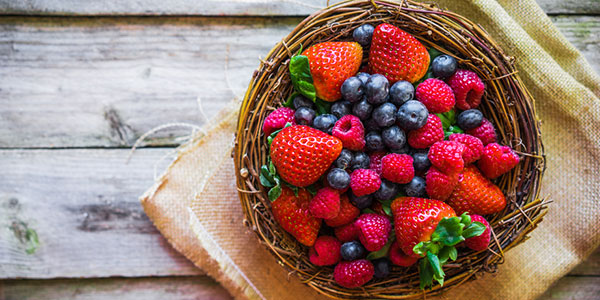
Strawberries, blueberries, gooseberries, goji berries, and the list goes on...
With so many berry options and variations, how do you choose? Learn about all the "berry" good health benefits of berries and some of the healthiest choices to enjoy!
Benefits of Berries
Berries are some of the most respected healthiest fruits. They offer a number of benefits, particularly related to their robust nutrition profile.
Berry Nutrition
According to the USDA National Nutrient Database, 1 cup (or 148 grams) of blueberries provides:
• 84 calories
• 1.1 grams (g) protein
• 0.5 g fat
• 21.5 g carb
• 3.6 g fiber
Berries are also a rich source of vitamins and minerals. These include vitamin C, vitamin K, copper, and folate, and manganese.
However, berry nutrition can vary based on the type. As a whole, though, they are low in calorie while offering numerous nutrients and plant compounds.
1. Berries supply powerful antioxidants.
Berries are one of the best sources of antioxidants, chemicals that may prevent or delay cell damage. These properties may reduce inflammation and boost the immune system.
While the body can produce antioxidants, the bulk of their existence comes from the foods consumed. Antioxidants are robust in fruits and vegetables, including berries.
Antioxidants are commonly explored in their defense against aging. This includes promoting longevity and protecting from diseases linked to aging, including Alzheimer's disease. Antioxidants themselves may reduce the risk of heart disease and prevent cancer, too.
2. Berries are low on the glycemic index.
The glycemic index (GI) measures and ranks carbs based on their immediate effect on blood sugar levels. It is a specially valuable measure for those managing type 2 diabetes.
A food with a GI of 55 or lower has the least impact on blood sugar. Berries are considered amongst the best low-glycemic fruits for diabetes. For instance, blueberries have a glycemic index score of 25. The GI of strawberries is 41.
Generally, lower GI foods supply more nutrients, including vitamins, minerals, and fiber. They likewise tend to keep hunger at more bay compared to high GI foods.
3. The fiber in berries supports digestive health.
Berries are a rich fiber source, often containing an average of 4 grams of fiber per cup.
Dietary fiber is imperative for keeping bowels regular and combatting against constipation. Adequate fiber intake can also protect against conditions of the bowel, including hemorrhoids and various cancers.
4. Berries are a heart-healthy food.
Berries offer several heart health properties, including antioxidants. The combination of antioxidants and fiber may improve cholesterol levels, in turn lowering heart disease risk.
The 'blue' in blueberries can help lower blood pressure, while vitamin K has an imperative role in effective blood clotting.
5. Berries can support eye health.
Some berries, especially Goji, contain the carotenoid zeaxanthin. Zeaxanthin shows to protect eyes from harmful high-energy light, including ultraviolet rays from the sun.
Antioxidant-rich foods may lower the risk age-related macular degeneration (AMD), the primary cause of vision loss in the elderly. The rich vitamin C content may reduce the risk of cataracts, or the clouding of the eye's lens, too.
6. Berries promote good skin health.
The high content of carotenoids and polyphenols, two potent antioxidants, have been suggested to combat against oxidants. The beneficial properties can inhibit cell death that likely contributes to accelerated aging.
The vitamin C content also has a role in defying age thanks to its antioxidant properties and need for collagen creation. An animal study suggests drinking the juice of goji berries protects against sun damage, subsequently reducing skin cancer.
7. Berries may improve mood.
In addition to physical benefits, berries may improve mental health.
In fact, research in Journal of Alternative and Complementary Medicine suggests daily consumption of goji increases feelings of well-being. Subjects further improved neurological and psychological performance in just a mere 14 days.
Another study in Nutrients suggests blueberries increases positive affect or mood. This includes the experiences of positive emotions such as joy.
Picking the Healthiest Berries
From strawberries to boysenberries, berry varieties are abundant. Enjoy some of the healthiest berries out there:
Strawberry
Did you know California strawberries account for 80 percent of the total U.S. strawberry production? So thanks to the warm climate, California has been able to nourish the body with vitamin c, fiber, and antioxidants. Other warm locations or summer seasons are also able to produce those refreshing strawberries.
Blueberry
Although small in size, blueberries are jam-packed with nutrients. Blueberries contain powerful antioxidants that help keep the body's cells protected from damage. The high fiber content and low cholesterol content support heart health. Fresh blueberries tend to be found between May and August but vary related to growing locations and conditions.
Blackberry
In the United States, picking seasons of these seedy berries vary across regions. Blackberries generally peak in during June in the south and during July in the north. Like blueberries, the rich color of blackberries confirms high antioxidant levels. Its superior antioxidant level can reduce the risk of age-related conditions and other chronic diseases.
Raspberry
Though raspberries were thought to have evolved from eastern Asia, they can be found in temperate climates around the world today. Red raspberries are a commercial staple, though black and purple varieties also exist in limited quantities.
Boysenberry
This blackberry lookalike is primarily a cross-breed of blackberry, raspberry, and loganberry. Boysenberries are loaded with dietary fiber and offer a small amount of protein. The large, maroon berries can be found fresh between mid-July to mid-August.
Gooseberry
Gooseberries are summer season berries that are visually unique compared to other berries. They are generally small, ribbed, and translucent and come in varying shades of yellow, green, red, and even black.
Cranberry
Unlike popular belief, cranberries are not grown in water. Instead, fall harvesters flood growing patches and use water reels to churn the butter and loosen the cranberry vines. Cranberries are known to play a preventative role against urinary tract infections.
Goji Berry
Also called the wolfberry, goji berries are native to China. The bright orange-red color of goji berries offers rich nutrients suggested to induce calmness.
Bilberry
This blueberry relative was historically used to treat a wide variety of conditions. What's more they are still used today as a traditional medicine for diarrhea and menstrual cramps. Bilberries are commonly a late summer, early fall berry crop.





